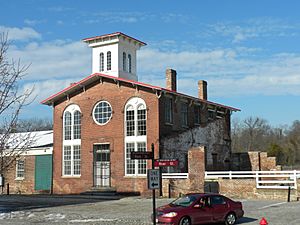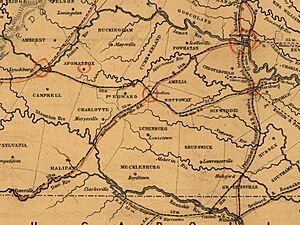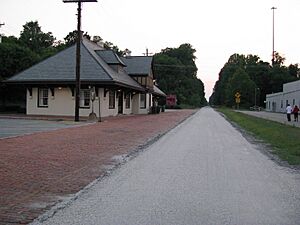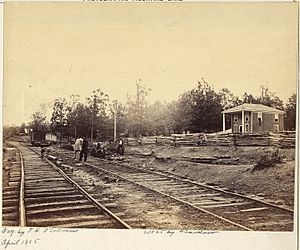Southside Railroad (Virginia) facts for kids
The Southside Railroad was a very important railway built in Virginia starting in 1849. It was finished in 1854. This railroad connected City Point, a port on the James River, to the farming areas southwest of Petersburg, Virginia. It then went all the way to Lynchburg, Virginia, covering about 132 miles (212 km).

South Side Railroad Depot in Petersburg, VA at corner of Rock and River streets, built 1851, 1853.
|
|
| Overview | |
|---|---|
| Headquarters | Petersburg, Virginia |
| Locale | Virginia |
| Dates of operation | 1854–1870 |
| Successor | Atlantic, Mississippi and Ohio Railroad |
| Technical | |
| Track gauge | 5 ft (1,524 mm) gauge |
| Length | 132 miles (212 km) |

The Southside Railroad was very important for the Confederate States of America during the American Civil War (1861–1865). The war caused a lot of damage to the railroad. After the war, it was rebuilt. It later became a key part of the Norfolk and Western and Norfolk Southern railway lines. These lines carried coal from the mountains to the port at Hampton Roads. Even today, much of the old Southside Railroad route is still used. It carries containers and car parts.
Contents
Building the Southside Railroad
The state of Virginia officially approved the new Southside Railroad in 1846. They planned to spend $1 million on the project. Virginia also gave its shares in the Petersburg Railroad to the City of Petersburg. This was to help build the Southside Railroad. The only rule was that construction had to begin within three years.
The railroad's leaders decided to extend the line to Lynchburg. There, it would connect with the Richmond and Danville Railroad. They bought a huge amount of iron (four and a half thousand tons) from England. This iron was brought by ship to City Point. They also bought 20,000 railroad ties. These ties were made from strong, rot-resistant trees like Juniper, American Chestnut, and Post Oak.
The company bought land to build a depot, which is like a train station and storage area. They hired engineers and 17 enslaved Africans to help with the work. To build the entire line, they hired 16 contractors. Each contractor had wagons, carts, horses, and almost 800 workers in total. The city of Petersburg invested over $400,000. Many individual investors also put money into the project. The City of Farmville bought $100,000 worth of shares. This allowed the company to start building the railroad.
Construction began in 1849 from the eastern end. By 1852, the railroad reached Burkeville. Here, it connected with the Richmond and Danville Railroad.
The Southside Railroad took a longer path through Farmville. This was because the community offered money to the railroad. Near Farmville, they built the famous 21-span High Bridge. This bridge crossed the Appomattox River valley. It was about 2,400 feet (730 m) long and 117 feet (36 m) high in the middle. It was one of the biggest bridges in the world when it was built!
The Southside Railroad was completed to Percival Island in 1854. This island is across the James River from Lynchburg.
Also in 1854, the Southside Railroad bought the 9-mile (14 km) long City Point Railroad. This smaller railroad had been bought by the City of Petersburg in 1847. It was renamed the Appomattox Railroad. It ran along the Appomattox River from Petersburg to where it met the James River at City Point. This was a perfect link for the Southside Railroad to reach a deep-water port. Here, steamships could connect to the larger river.
Stations and Connections
The Southside Railroad had many stations along its route. These stations helped people and goods travel across Virginia.
South Side Railroad Stations
- City Point Spur (formerly City Point Railroad)
- Petersburg
- to Shops Spur
Main Line
- Sutherland's (10 miles)
- Ford's (20 miles)
- Wilson's (Water stop) (27 miles)
- Wellville (31 miles)
- Blacks & Whites (37 miles)
- Nottoway (43 miles)
- Burkeville (Junction with the Richmond and Danville Railroad) (52 miles)
- Rice's (61 miles)
- High Bridge (65 miles)
- Farmville (69 miles)
- Prospect (80 miles)
- Pamplin's (88 miles)
- Evergreen (94 miles)
- Appomattox (100 miles)
- Spout Spring (106 miles)
- Concord (111 miles)
- Lynchburg (124 miles)
By late 1860, the Southside Railroad connected with other important transportation routes:
- Petersburg
- Petersburg Railroad: Went south to Weldon, North Carolina.
- Richmond and Petersburg Railroad: Went north to Richmond.
- Norfolk and Petersburg Railroad: Went east to Suffolk and Norfolk.
- Burkeville
- Richmond and Danville Railroad: Went northeast to Richmond and southwest to Danville.
- Lynchburg
- James River and Kanawha Canal: Went east to Richmond.
- Virginia and Tennessee Railroad: Went west to Salem and Bristol. It also connected to lines going all the way to New Orleans.
- Orange and Alexandria Railroad: Went northeast through the Piedmont region to Charlottesville and Alexandria.
The Railroad During the Civil War
The Southside Railroad was a very important supply line for the Confederate States Army in Richmond and Petersburg during the American Civil War (1861–1865). For most of the war, it was behind the battle lines. The main problem it faced was financial weakness.
Near the end of the war, the Confederate army destroyed most of the rail lines around Petersburg. Half of the eight-mile City Point Railroad was completely removed. Another two miles were too damaged to fix. Only two and a half miles of track near Petersburg could be saved.
The United States Army (Union forces) rebuilt parts of the railroad. Lieutenant General Ulysses S. Grant needed a railroad to bring supplies for the Siege of Petersburg. He knew from past experience that it would be necessary. Grant asked Mr. C. L. McAlpine, an engineer, to rebuild the City Point to Petersburg Railroad. This happened as soon as the fighting moved away. McAlpine started work on June 18, 1864.
The City Point part of the Southside Railroad was very valuable to the Union forces during the Siege of Petersburg in 1864-65. General Grant used and extended it. This helped him move supplies and troops from the port at City Point to the area south and east of Petersburg. The U.S. Government operated it as a military railroad. In the last year of the Civil War, the U.S. Government rebuilt ten miles of tracks. They also built a hospital and a bakery along the Southside Railroad. They even rebuilt trestle bridges.

Stations & Waypoints of the Military Railroad
- City Point Terminus (Mile 0)
- Hospital spur (Mile 1.5)
- Wood Pile (Mile 2)
- Cedar Level Station (Mile 4)
- Clark's Station (Mile 4.25)
- Pitkin's Junction (Mile 5.75)
- Birney's Station (Mile 7)
- Meade's Station (Mile 8)
- "Shooting Hill" (Mile 9)
- Hancock's Junction/Jerusalem Plank Road (Mile 11)
- Gregg's Station (Mile 12 S)
- Crawford's Station Terminus (Mile 13.5 S)
- Parke's Station (Mile 13 N)
- Warren's Junction/Weldon Railroad (Mile 14.5 N)
- Patrick's Station Terminus (Mile 16 N)
- Humphreys Station Terminus (Mile 18.5 S)
After the War: A New Railroad
After the Civil War, the owners of the Southside Railroad chose William Mahone as their new president. He was a former general in the Confederate army. He was famous for his part in the Battle of the Crater.
In the years after the war, William Mahone worked hard to connect the Norfolk and Petersburg, Southside Railroad, and the Virginia and Tennessee Railroad. By the end of 1867, he was president of all three. Mahone wanted to combine them into one big railroad and expand it westward. He convinced the Virginia General Assembly to pass laws to create the Atlantic, Mississippi & Ohio Railroad (AM&O). This new railroad was formed in 1870. It was made up of the three railroads he led. It stretched 408 miles (657 km) from Norfolk to Bristol, Virginia. The old Southside Railroad became one of the three main parts of the AM&O.
The Southside Railroad Today
The path of the old Southside Railroad became a big part of the Norfolk and Western railway. This line was used to carry bituminous coal from mines in southwestern Virginia and southern West Virginia to the port at Norfolk. A huge coal pier was built there at Lambert's Point.
More than 150 years after it was finished, much of the old Southside Railroad route was still actively used. However, in 2005, this part of the railway was no longer used for trains. It was then given to the Virginia Department of Conservation and Recreation (DCR). They turned it into a walking and biking trail called High Bridge Trail State Park.
Work on the High Bridge for the park began on March 7, 2011. The bridge officially opened to the public on April 5, 2012. The bridge itself was fixed up using a $2 million grant. It is the most famous part of the park. The trail is 31 miles (50 km) long. It runs from Burkeville to Pamplin City. The park service is still working to get the very ends of the trail to complete it.
Leaders of the Railroad
- William Pannill (August 22, 1849 – 1856)
- Thomas H. Campbell (1857 – 1860 or after)
- Lemuel Peebles (1860 or after – December 1865)
- William Mahone (December 1865 – 1870)





